The Historic Mount Washington Hotel at Bretton Woods, NH
Explore the historic highlights of the iconic Mount Washington Hotel at Bretton Woods, NH – one of New England’s few remaining grand hotels.
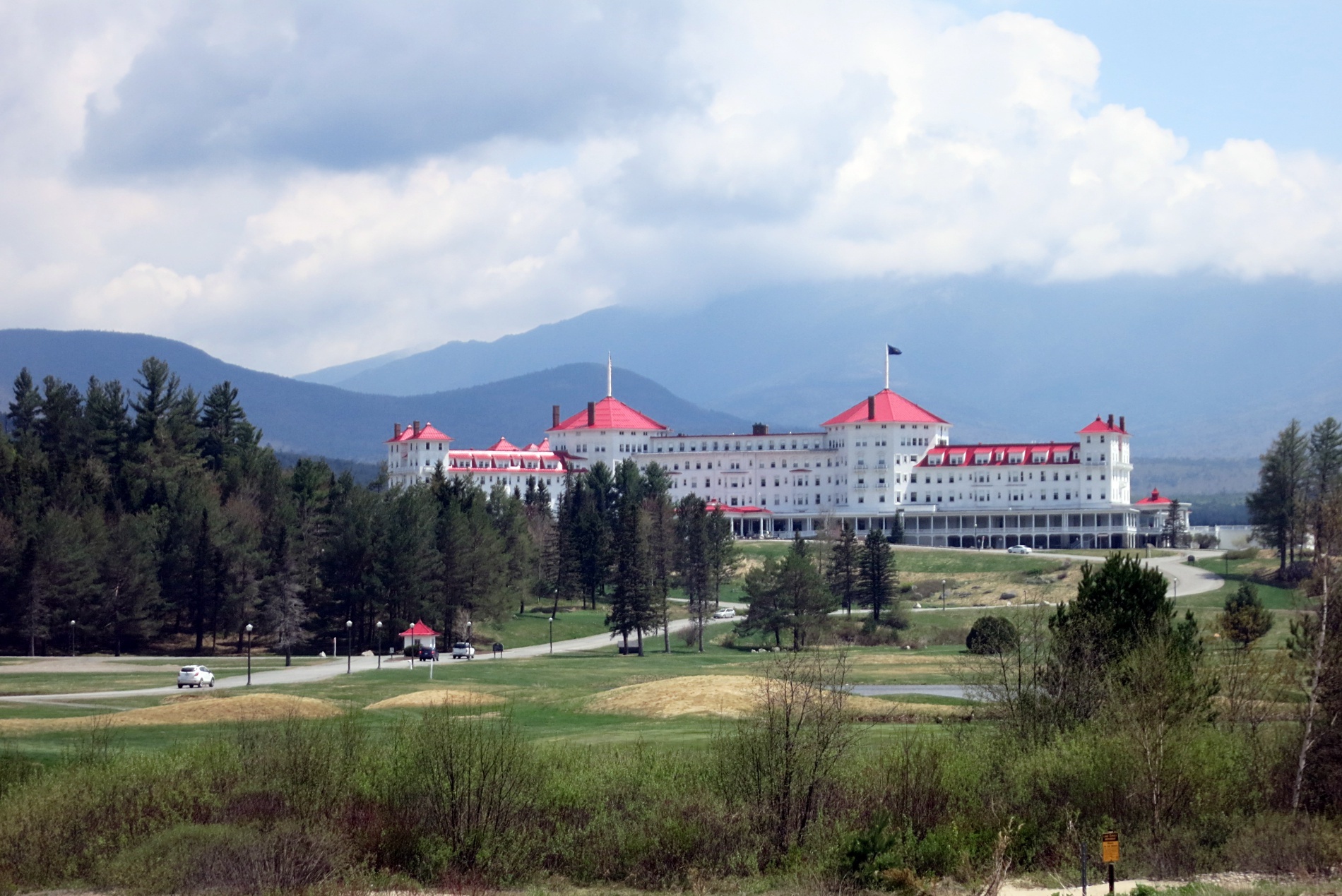
Coffee By Design | Portland, Maine
Photo Credit : Katherine KeenanAs one of the few remaining grand hotels in New England, the Omni Mount Washington Hotel at Bretton Woods, NH, is a true White Mountains treasure. To visit is to time-travel back to the railroad-era of the early 1900s, when wealthy city-dwellers journeyed north to spend their entire summers in the fresh mountain air, but beyond history, the hotel also prides itself on more than a century of hospitality in one of the most beautiful settings in the country.
The iconic White Mountains hotel is the flagship property of the Omni Mount Washington Resort, and was originally built by wealthy New Hampshire native Joseph Stickney. Designed by architect Charles Alling Gifford, the project began in 1900 and was completed in July, 1902. Its style is Spanish Renaissance Revival (hence the red roof to mimic the tiled roofs of Spain), and construction included more than 2,000 doors, 900 kegs of nails, 11 miles of plumbing, and more than 1,200 windows.
It was an instant summer success.
Guests arrived by train from Boston and Portland and were brought to the hotel via horse and carriage, and it’s easy to imagine their view upon arrival — motorists experience the same “wow” moment today heading up the hotel’s long drive.
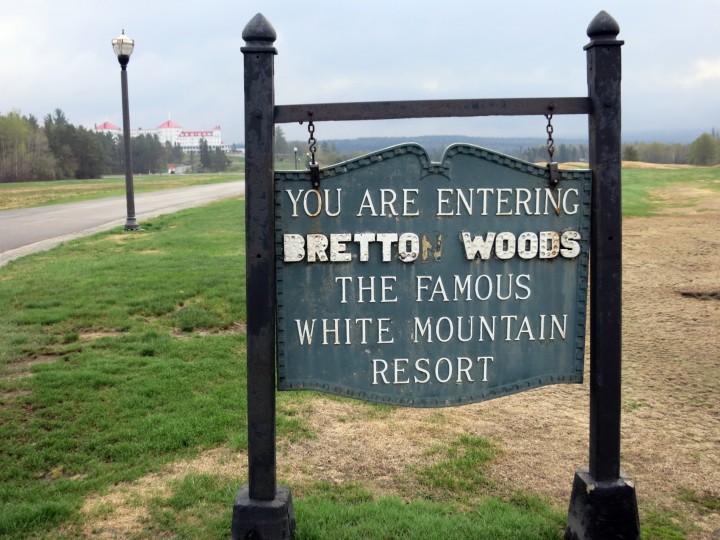
Photo Credit : AImee Seavey
The name Bretton Woods has always confused me…is it another name for the hotel? The town it’s in? Where is Bretton Woods? To clarify, Bretton Woods (where the hotel is located) is a village in the town of Carroll, NH. Because the hotel was so often referred to as “The Mount Washington Hotel at Bretton Woods,” the names became synonymous.
Today, the hotel offers not just a place to stay and dine in luxurious comfort, but numerous amenities such as two golf courses, skiing, a spa, tennis, and horseback riding. For many guests, however, the hotel’s history alone is enough of a reason to visit.
Well, that and the mountain views, which are spectacular.
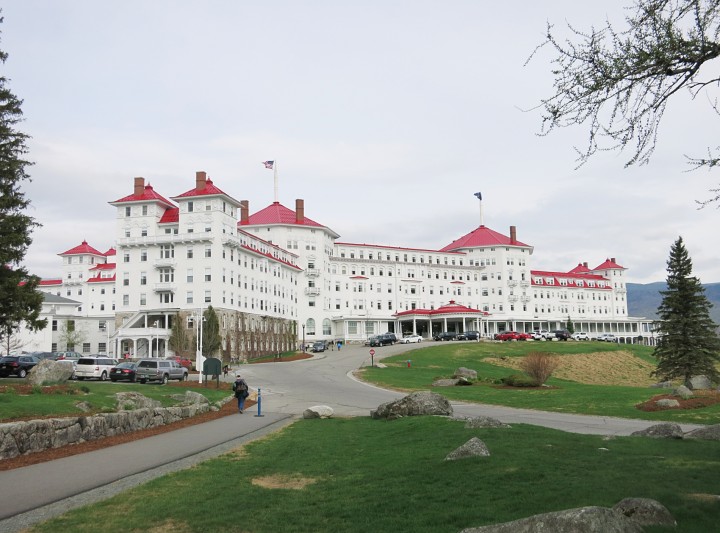
Photo Credit : Aimee Seavey
My visit was in late spring (the reason was a trip up Mount Washington on the Mount Washington Cog Railway), and the weather wasn’t entirely cooperating. The sky was heavy with clouds and fog, but sometimes, the sun would wrestle through and bathe the landscape with a few moments of sunshine. I can only imagine how the mountains must look on a clear summer day or snow-covered winter morning…
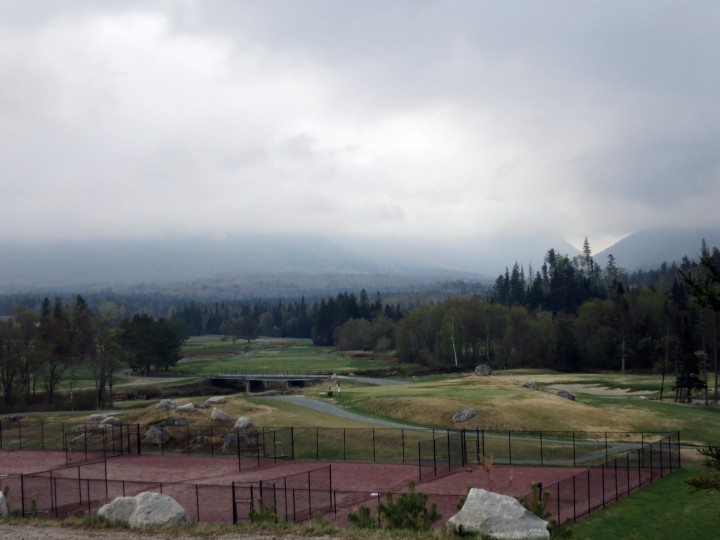
Photo Credit : Aimee Seavey
Inside the Mount Washington Hotel, you’re greeted by the enormous French Renaissance-style Great Hall with large windows on either side to encourage cross-breezes in the days before air conditioning. Originally called the Assembly Hall, the focal point of the room is a giant fieldstone fireplace, but the several crystal chandeliers (added in the 1920s) are also pretty impressive. The room underwent a massive restoration in 2007, and period photographs and postcards were consulted to help re-incorporate original historic details back into the decor. Examples of this are the moose head mounted above the fireplace, and the custom carpeting that depicts local flora and fauna.
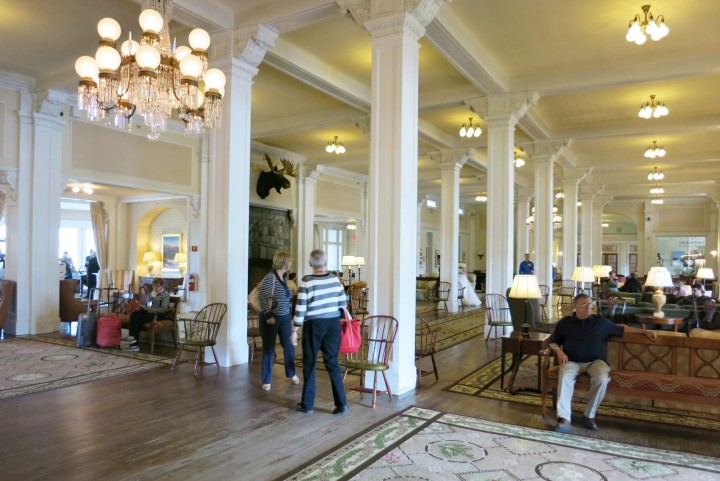
Photo Credit : AImee Seavey
Of special note is the 19th century grandfather clock tucked to the left of the fireplace. Before the hotel was open year-round (starting in 2001), the starting of the clock signaled the beginning of the summer season. On the final day, the last guest would stop the pendulum until the following season began. The clock is one of the few original pieces remaining in the Mount Washington Hotel Great Hall.
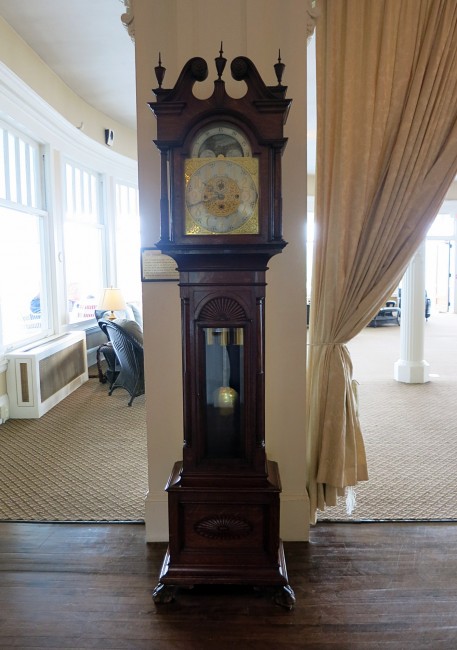
Photo Credit : Aimee Seavey
Beyond the Great Hall (behind the moose) is the Mount Washington Hotel Conservatory. Originally called the Hemicycle, the half-circle shaped sun parlor is made almost entirely of plate glass with stunning views of the Presidential Range. Its domed ceiling, ringed with Tiffany glass, gives the room natural acoustics that make it an ideal spot for concerts, lectures, and poetry readings. The room is also home to an original 1881 Steinway piano, so make sure you don’t set your drink down on it — its value has been estimated in the hundreds of thousands of dollars!
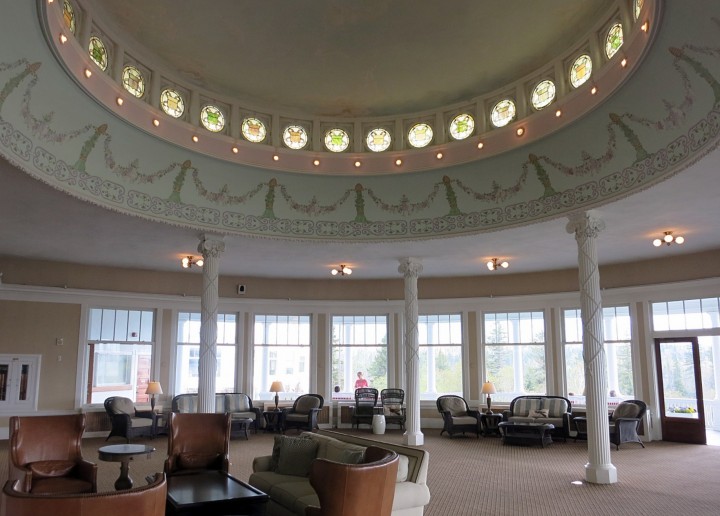
Photo Credit : AImee Seavey
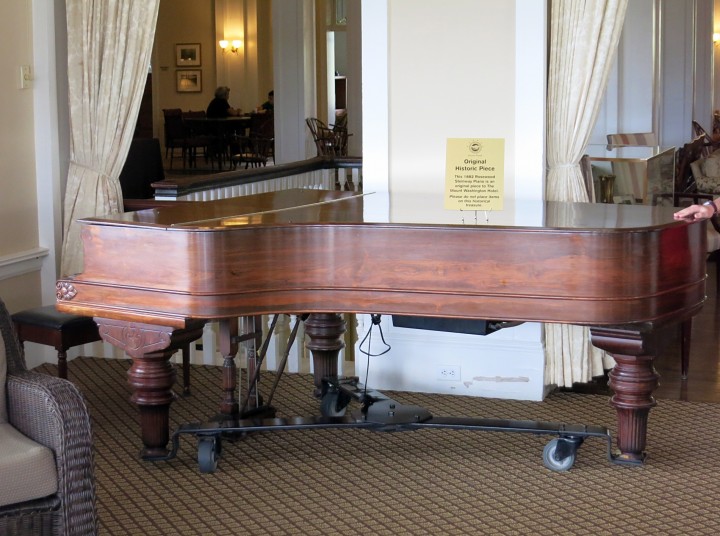
Photo Credit : Aimee Seavey
Beyond the Conservatory is the spectacular covered outdoor Veranda. Spanning 903-feet, it’s the longest in New England. Six laps around the Veranda guaranteed early 20th century guests (and still does today) a healthy mile of exercise when the weather was poor, and between its 122 columns, gorgeous views of the mountains and grounds offered plenty to admire. Of course, you can also choose to sit in one of the hotel’s many comfy wicker offerings to admire the scenery or sip a coffee. Verandas and wicker go together like peanut butter and Fluff here in New England, don’t they?
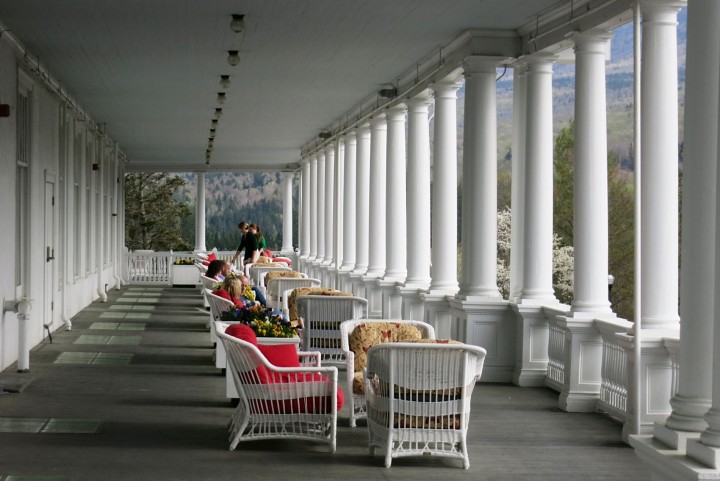
Photo Credit : Aimee Tucker
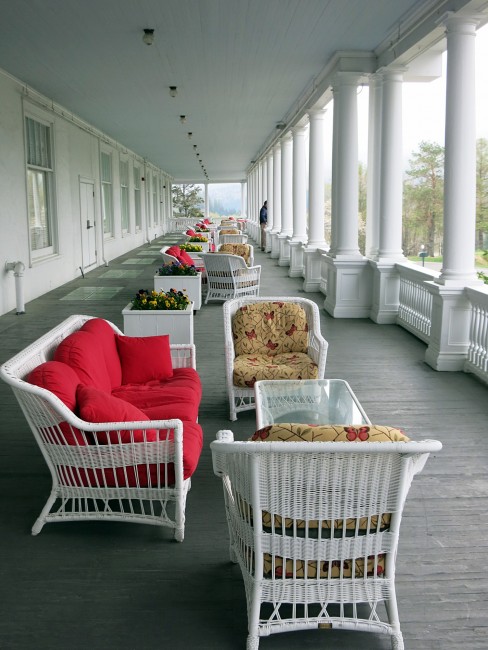
Photo Credit : Aimee Seavey
Jutting off the back right side of the main level of the hotel, the open-air Jewell Terrace (the Conference Center and Spa, built in 2008, is underneath) also affords a lovely view. I didn’t get a chance to enjoy the Mount Washington Hotel Spa, but I hear it offers multiple indulgences, skin care, body treatments, and regular salon services.
There’s that sun trying to beat back the clouds!
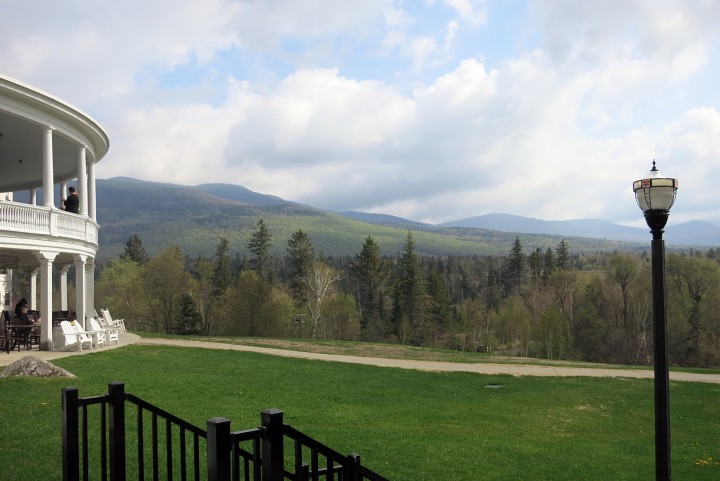
Photo Credit : AImee Seavey
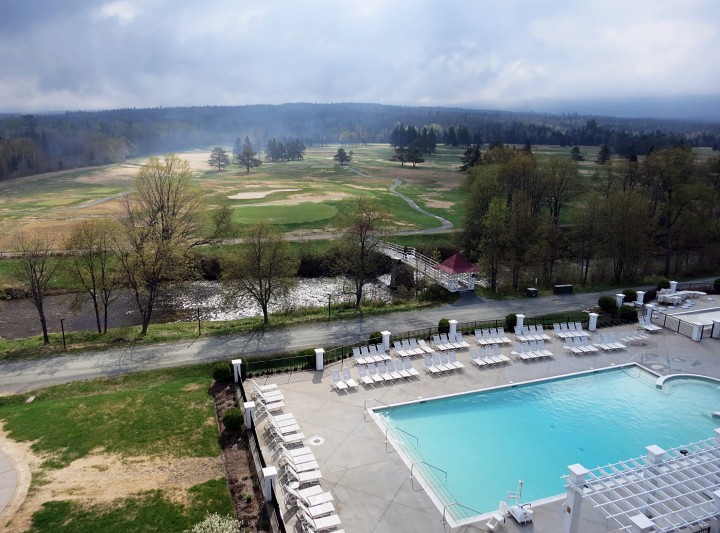
Photo Credit : Aimee Seavey
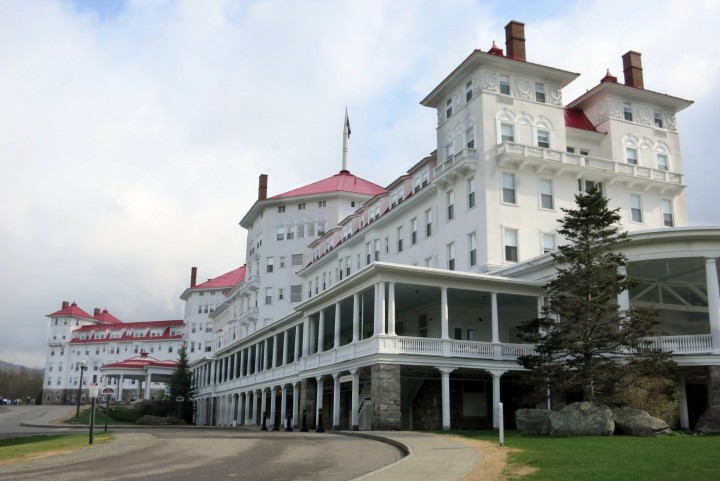
Photo Credit : AImee Seavey
Back inside, to the right of the Main Hall, is one of the Mount Washington Hotel’s most significant rooms — the Gold Room. It represents both the hotel’s rebirth after years of wartime vacancy, and an important event in world history.
Hotel business had waned during the 1930s, with Prohibition and the Great Depression (not to mention the nimble automobile) taking an enormous toll on the hospitality industry. After Carolyn Stickney (the wife of founder Joseph Stickney) died in 1936, her nephew inherited the hotel, but when World War II broke out in 1942, he decided to close. Two years later, a Boston syndicate bought the property for $450,000, and when the government was searching for an ideal location to hold a worldwide conference to deal with the financial aftermath of the war (now known as the Bretton Woods Conference), they chose the Mount Washington because of its secure location and ample room for the 730 delegates from 44 nations that would be attending.
Unfortunately, the Mount Washington Hotel had been vacant for several years and was badly in need of repairs. Roofs had collapsed under heavy snow and wallpaper was peeling off the walls. Undaunted, the government sent in 150 workers armed with new furniture and 50 cans each of white paint. With just 2 months until the Conference, they were told that if it didn’t move, to paint it white…and (gulp) that’s just what they did. The paint made everything look clean and new, but the workers weren’t concerned with historic preservation, so they painted right over the mahogany doors, brass fixtures in the Great Hall, and even some of the Tiffany windows.
The Conference took place over 21 days in July, 1944 (the owners were paid $300,000 for the loss of business and a daily room charge of $18 per person) and concluded with the signing of the final Articles of Agreement for the International Monetary Conference. This (among other things) established the World Bank, the International Monetary Fund, the gold standard, and U.S. currency as king — all of which were intended to restore worldwide financial stability and prosperity after the devastation of World War II.
While meetings took place all over the crowded hotel, the Gold Room, with its 14 chairs for the 14 power nations that took part in the formal signing, endures as a tribute. The table (originally Carolyn Stickney’s own private dining table) is the same one on which the documents were signed, and the light fixture above is a gasolier, a kind of electric lamp that also included gas in case the power should go out during the Conference.
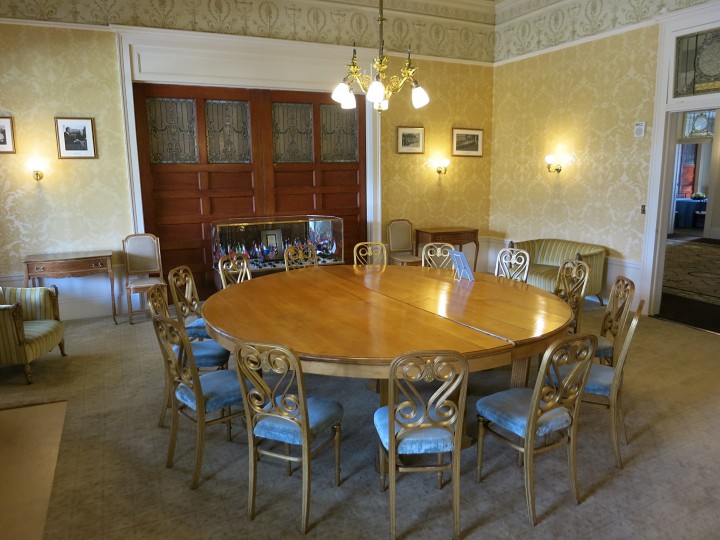
Photo Credit : Aimee Seavey
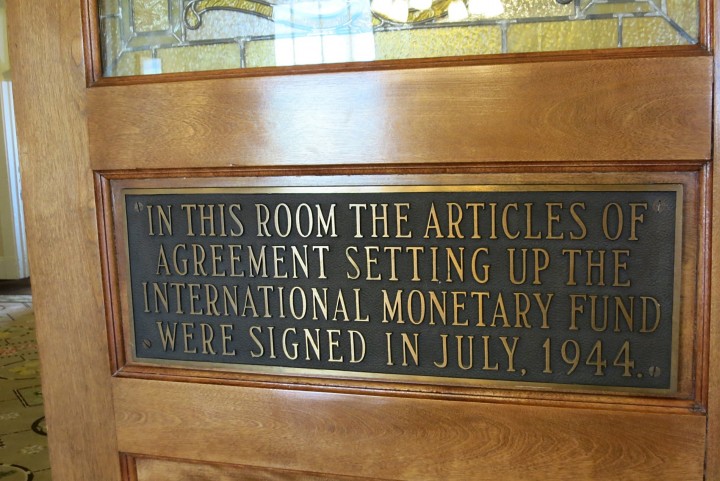
Photo Credit : AImee Seavey
Beyond the Gold Room is the Omni Mount Washington Hotel Grand Ballroom. Today, it looks very much like any other Grand Ballroom in a fine hotel, playing frequent host to weddings, meetings, and other large social occasions. Look closely, though, and you’ll see the original Tiffany glass between the columns. How many hotel ballrooms can say they have that!?
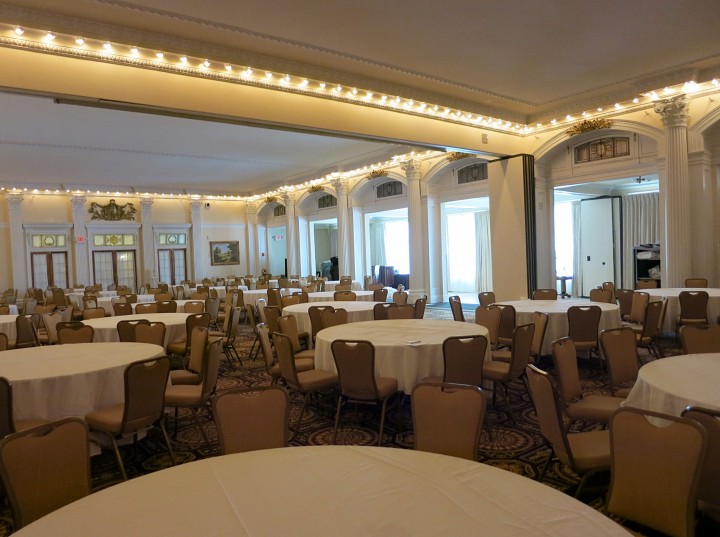
Photo Credit : Aimee Seavey
And on the other side of the Great Hall (let’s pause for a moment and say hello again to the Great Hall moose as we traipse the long length of it)…
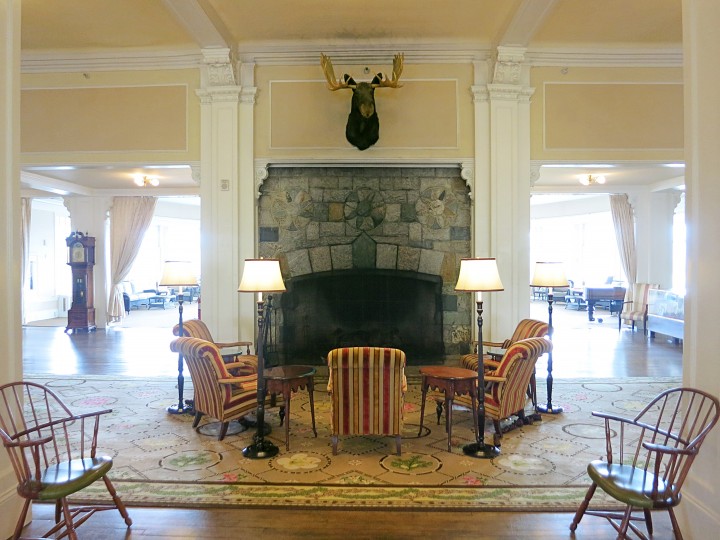
Photo Credit : Aimee Seavey
…you’ll find the Grand Staircase leading up to the guest rooms, across from the reception area. The stairs are wide and shallow, allowing for the ladies of the day to easily travel up and down without tripping over their skirts.
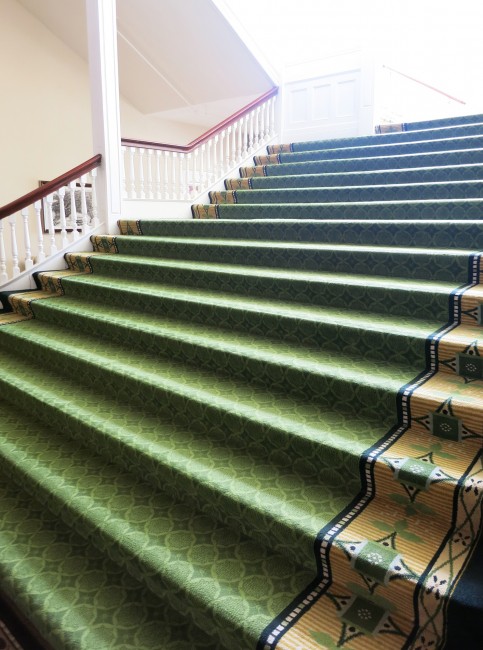
Photo Credit : Aimee Seavey
In fact, it’s said that Carolyn Stickney used to watch the nightly procession from behind a curtain on the balcony near the Front Desk. If she saw a lady with a finer dress than the one she intended to wear to dinner, she would change before making her own entrance.
This endearing critical tradition is memorialized in a painting at the hotel in the spot where the balcony once was.
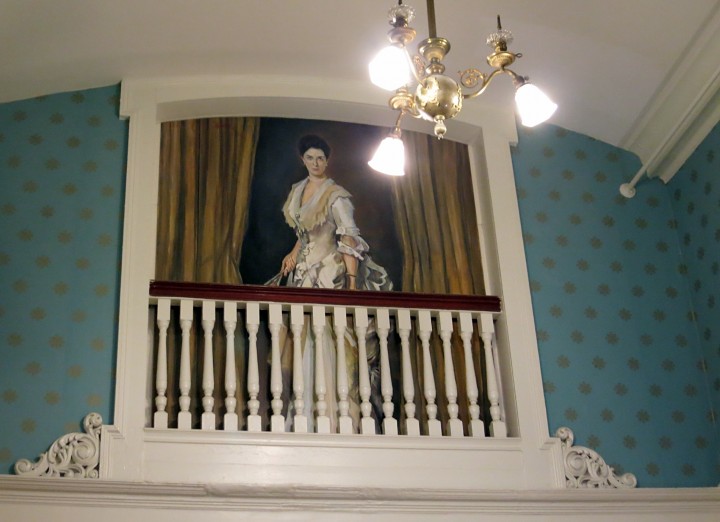
Photo Credit : Aimee Seavey
To the left of the stairs are the Princess Room and Main Dining Room. The Princess Room was Carolyn Stickney’s private dining room. Today it’s one of the few spots in the hotel that escaped the great white paint incident of 1944, making its gold-leaf accents a lucky remainder from the hotel’s original decor.
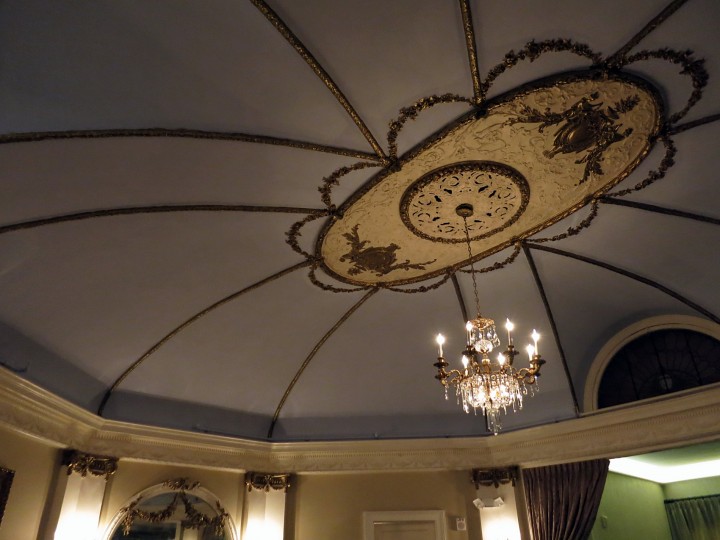
Photo Credit : Aimee Seavey
Large and sunny in comparison, the Main Dining Room at the hotel was octagonal in shape so that no guest might feel the shame of being placed in the corner, and afforded beautiful views of the mountains. An extension of the dining room, called the Sun Dining Room, was added in 1906.
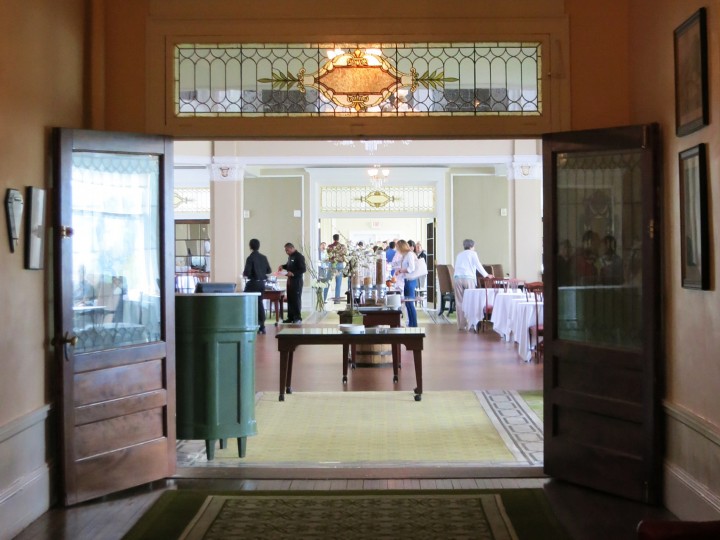
Photo Credit : Aimee Seavey
Along with an orchestra, the Bretton Woods Boy Singers (which included my father and uncles in the 1960s) would perform in balconies on either side of the room, and recent restorations have revealed the room’s original Tiffany windows and brass fixtures under multiple layers of paint.
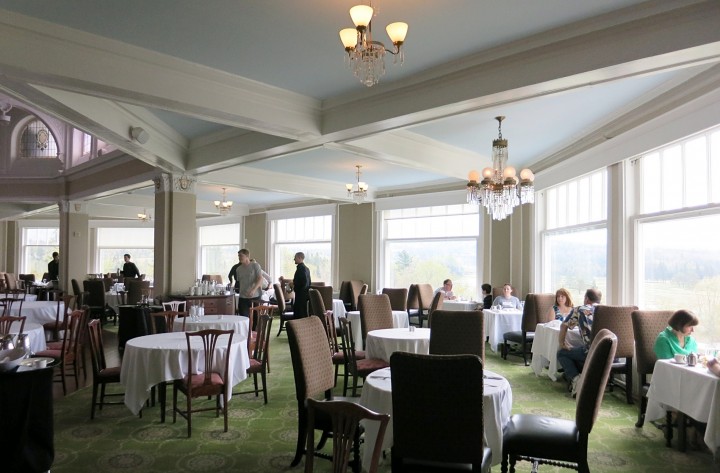
Photo Credit : AImee Seavey
Heading down to the hotel’s lower-level (or “Patio Level”), sun-filled rooms give way to shadowy brick, although the flora and fauna custom carpet continues. Here, a blend of old and new have created an entirely unique space.
What was once a bowling alley is now a conference room, a ladies lounge a gift shop, and the hotel’s billiards room a casual restaurant named after the hotel’s founder.
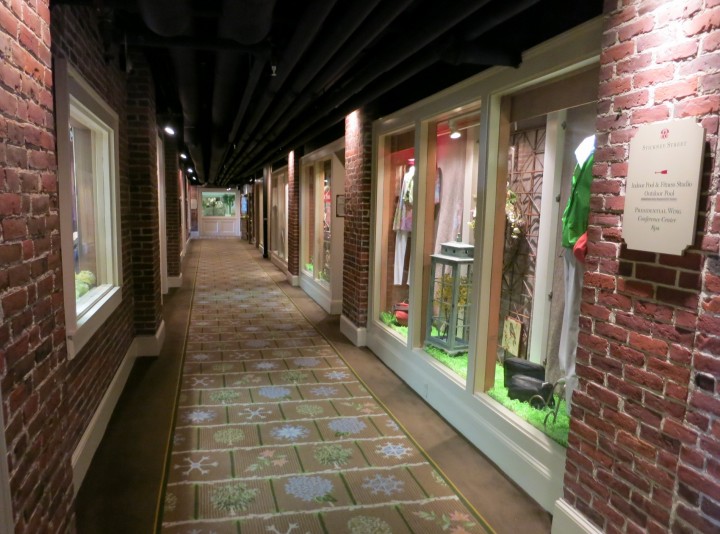
Photo Credit : Aimee Seavey
There’s also a cafe, arcade and candy shop for kids, and even a Post Office — at one time, the only hotel Post Office with its own zip code (03575).
Of special note is a bar known as Cave. Originally the hotel’s squash courts, the space was later converted into a bar and grill, and was a speakeasy during Prohibition, with guests drinking spirits out of teacups.
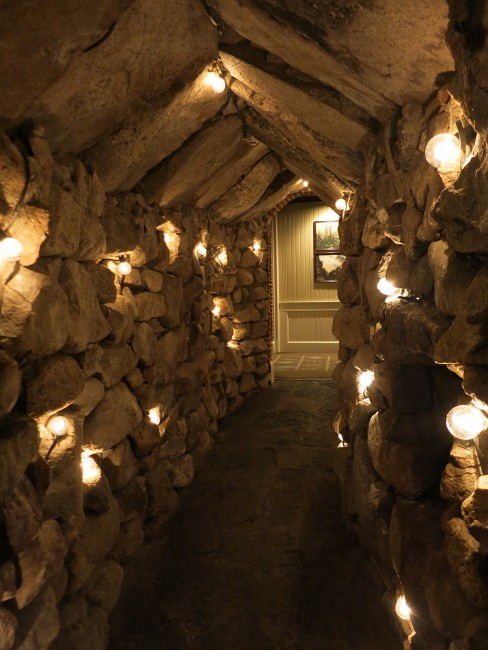
Photo Credit : Aimee Seavey
Today, it remains a popular watering hole, sometimes with live music.
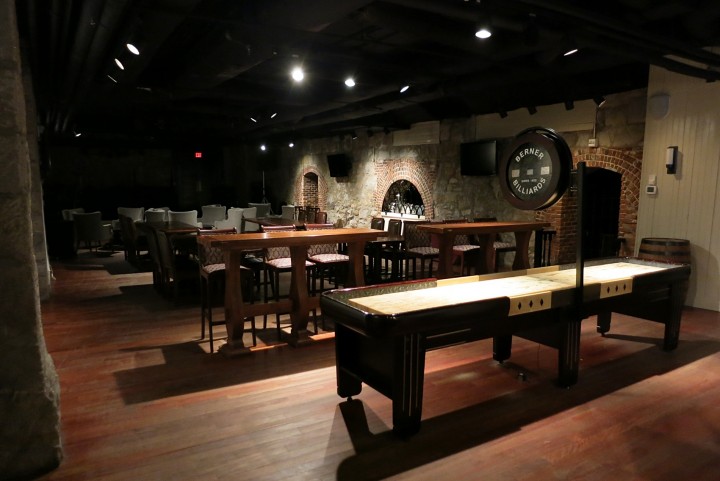
Photo Credit : AImee Seavey
There’s also the hotel’s indoor pool — one of the first of its kind in the country. When Carolyn Stickney was in the mood for a swim, all of the other guests would have to get out and leave the room until she was finished.
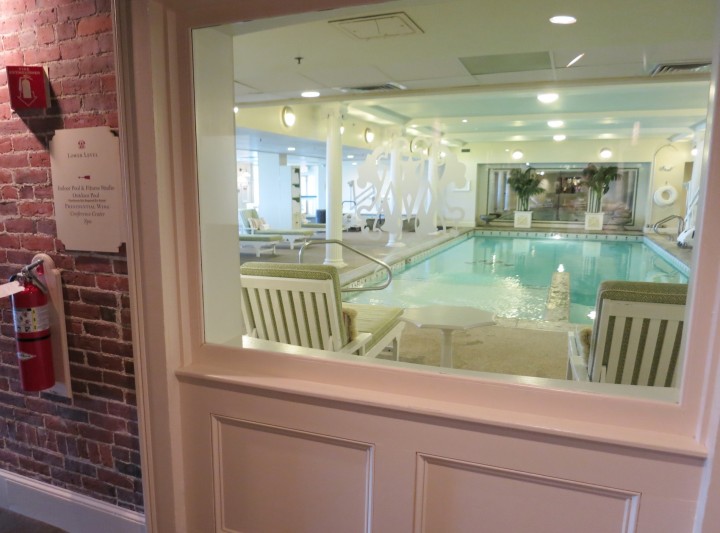
Photo Credit : Aimee Seavey
So now we’ve seen the hotel’s Main Level, Patio Level, and natural surroundings — but what about one of the most important parts of a hotel, the guest rooms?
I can only show a photo of my own for the evening, a spacious room with an odd layout. Here, you can see the large main bedroom. Behind me is a bathroom that connects to a small, narrow sitting area (it was exactly the size of my one-person college dorm room), and the door to the hallway is in the sitting area — not the bedroom (although the bedroom has a door to the hallway, too.). Why the odd setup?
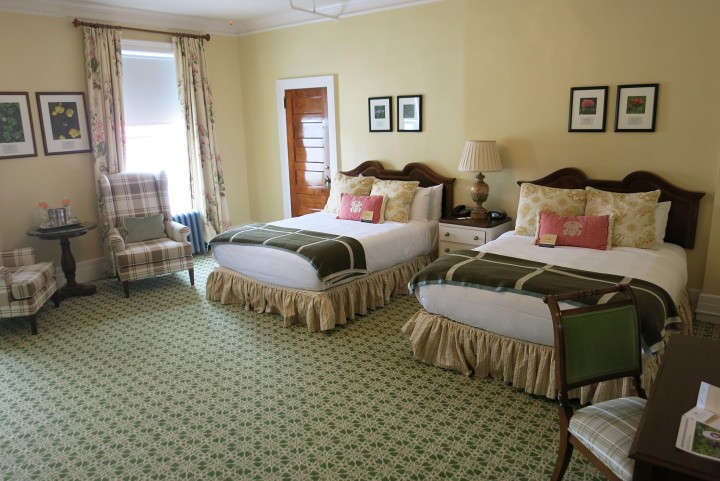
Photo Credit : AImee Seavey
When the Mount Washington Hotel was built, families would come for the entire summer, bringing not just mother, sometimes father, and children, but an entire staff. Their quarters were designed like connecting suites, with both large and small rooms to accommodate each guest. And since the hotel has been updated and renovated, but not rebuilt, they’ve had to fashion individual guest rooms out of the original multiple connecting suites. This leads to rooms that are curiously laid out, but wonderfully fun to navigate and imagine the previous inhabitants.
They’re also lovely, comfortable, and full of charm.
So there’s the lot of it, for this visit at least. With more than a century of history, hospitality, and tranquility to its name, it’s easy to see why the Mount Washington Hotel (declared a National Historic Landmark in 1986, and now a member of the Omni Hotels & Resorts since 2009) continues to attract visitors, and not just endure, but grow.
Before saying goodbye, I took one final stroll around the Veranda, admired the natural beauty of the White Mountains National Forest, and promised myself I’d be back soon.

Photo Credit : Aimee Seavey
Have you ever visited or stayed at the Mount Washington Hotel or another of New England’s grand hotels? Which is your favorite?
Omni Mount Washington Resort. 310 Mount Washington Hotel Road, Bretton Woods, NH. 603-278-1000; omnihotels.com.
This post was first published in 2015 and has been updated.




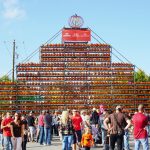



What a great photo tour. Thanks for showing us what has been an unknown
Thanks for bringing back great memories of our stay at this Grand place. We stayed there just before they added the conference room. The tour they gave us they mentioned a new conference room was planned. Our room had a beautiful view of the snow covered tips and a glorious view of the morning sunrise over the mountains. We vowed we would come back one day for another visit . At the time we were there they were still restoring some parts of the hotel . We were treated like royalty while there . thanks for this picture tour..enjoyed.
the ghost hunters from scifi network there
Great article and pics Aimee. It brought back fond memories of my several trips to this awesome place.
Jim
Thanks so much, Jim! I had a great visit!
I was a Bretton Woods Boy Singer with Bob Seavey, and, of course, in the choir at Good Shepherd in Reading and St. Paul’s in Boston. Bob was REALLY good. My Uncle, Richard Bond, was the director. He’s in his 90’s now, living in Keene, New Hampshire with my cousin Dave Bond, who was also in the choir, and his family.
Richard Bond and his sister, my mom, worked at the hotel for a few summers.
I remember seeing Rod Laver and Arthur Ashe play tennis in a tournament there, probably in 1970 ish?
Hi Stephen! Bob Seavey is my uncle (so is his brother Tommy, and Paul is my dad). All 3 were blessed with wonderful singing voices. Thanks for sharing your memories! I always enjoy learning more about the Bretton Woods Boy Singers — glad to hear your uncle is doing well!
I just stumbled upon the great article! My husband was a member of the Bretton Woods boy singers in the late 40’s . He is writing a memoir of his experiences for our grandkids.Did you visit the room with all the signatures of the boys. throughout the years? We do not have any pictures of his time there and I know there were formal photographs taken of each choir every summer. Do you know we might find any of those photos? Again I so enjoyed your article.
Nancy Shamp
I have stayed off property and gave myself a self guided tour. Thanks for sharing what I had missed well as the history! I just love it and all things White Mountains!!!
Aimee….I’ve been in search of (and contacted Bob) looking for the album….we used to have the record and I would love a cd of it. Any chance you have one as well? I know that Mark said he had one…but…..I’ll try to get in touch with him later on…Thanks so much…Merry Christmas!!
this is the kind of article that i wish you would do in every issue; the reason i have renewed my subscription is to have access to the history of new england and it’s architectural heritage. again, thank you for this article.
Great article.
reminds me of the balsams in dixville notch, n.h.
Thank you a million times!!! So many found memories of Mt. Washington Hotel and the whole area. I worked all my summers in nearby Fabyan, went to the hotel many times, rode the cog ( even shoveled some coal and braked it down the mountain a few times) hundreds of times and loved to follow the Bretton Woods Boy Singers all over N.H., swam in “upper falls” and “lower falls” but trips with the “Tip Top” bread man to the hotel and back was always fun! I love this place!
WE NEVER GOT TO STAY AT THE BRETTON WOODS HOTEL, BUT IT WAS GRAND AND IMPRESSIVE EVEN FROM THE ROAD. WE DID GET TO THE BALSAMS MANY YEARS AGO DURING THE SPECTACULAR AUTUMN DISPLAYS OF COLORS AND IT WAS A ONE OF A KIND EXPERIENCE —- BUT YOUR VIDEO AND PICTURES PORTRAY A MORE COMPLETE AND REWARDING EXPERIENCE. IT WOULD BE AN EASIER TRAVEL EXPERIENCE IF WE WERE STILL IN NJ, BUT WE BELIEVE IT IS WORTH THE AIR TRAVEL HASSLES. WE ARE LOOKING FORWARD TO THE ULTIMATE REVITALIZATION OF THE BALSAMS —— PERHAPS A 2 IN 1 VERY SPECIAL VISIT TO BOTH.
Aimee, We have stayed here 3 times…4th time coming up mid August 2018. Cannot wait! It is like walking into another time, and every member of the staff is friendly and gracious. We love going back for our anniversaries! Can’t wait!! Thanks for the great article and photos. Everyone should go at least once in their lives!!!
Lunch on the porch in the summer is wonderful. We ,however, like staying at The Mountain Grand View up the road. Another wonderful historic hotel.
We visited the hotel for a few hours a few years ago when we were staying at our timeshare in Lincoln. The resort did a free guided tour that met at the grandfather clock, I think at 10am. Someday I hope to spend XMAS there. My dream.
In 1960 I worked a summer as a busboy along with other college kids. Stayed in a dormitory located in the rear of the hotel. We worked the conventions in the spring and fall. The hotel closed during the winter months . Have fond memories of that summer. Most of the staff traveled back and forth from Miami where they worked in the hotels during the winter.
Wonderful memories you have shared. I lived in Campton, NH with my husband Mark when he was in charge of the golf courses starting in 2000 when the Hotel opened for the winter for the first time. I have many fond memories of skiing, having dinner at the Hotel and sharing the golf courses with others. I have retired to Florida and truly miss those wonderful days. Thank you!
Reminds me of the movie “The Shining”
This is our “go to” place to spend a few days celebrating something special: our 40th anniversary, our 50th and my husbands 75th birthday, among others. Sometimes my friend and I just go to have a fancy drink in the Rosewood bar, sit on the deck enjoying the mountain views and spend a couple hours “pretending we’re rich”. What fun! We’ve “treated” ourselves to spa visits a number of times. What an amazing experience, so pampered. Can’t wait for another visit. Truly special.
This building and it’s, uxuriousness look,an awful lot like the Sagamore in Boston NY (I think it is now the omni dunfy corporation which sherat8n hotle,s was,part,of for,awhile- i actuzlly transfered to,the sheratin on portland maine for a few years. I worked there for awhile, and what a grand place it was too. Majestic. 4 major resteraunts in it from casual,all the way to top of the line. The building was so vast I was still learning my way around d it many years later. It even ahd s e dret passageways that they used to make al. The help,use- though dark tunnel-like corridors. I did room,service, and waiter in the trillium. It was on an island, and we used vans to,get aroundmto,around to all the swanky cabins. Was a great job. Right on lake George. Anyways the front of the building looked very similar to,this,one above, and same roundabout to,the front door. Had a great time working there, woild,have loved working at themkne above too.
I meant the Sagamore in Bolton NY, not Boston – cursed autocorrect!
For people out of New England, how do you recommend traveling to Mount Washington and the Cog Railway? Should we fly to Boston and take a train? Fly to Portland and take a bus or rent a car?
personally I’d fly into Portland, rent a car- and take my time exploring Maine and NH- The coast has many great places to eat if you love seafood- renting a car gives you hte freedom to explore on your own schedule-
Enjoyed your article which brought back memories of a magnificent weekend years ago. Did the walk around the hotel on the veranda, found a movie(On Golden Pond playing continously)in a little room and I just stayed there in peace and quiet to enjoy the show. Joined a large group at dinner and remember the parade of Baked Alaska aflame. It was impressive along with a huge selection of other desserts. Nice memories. Maybe I’ll get a chance to return.